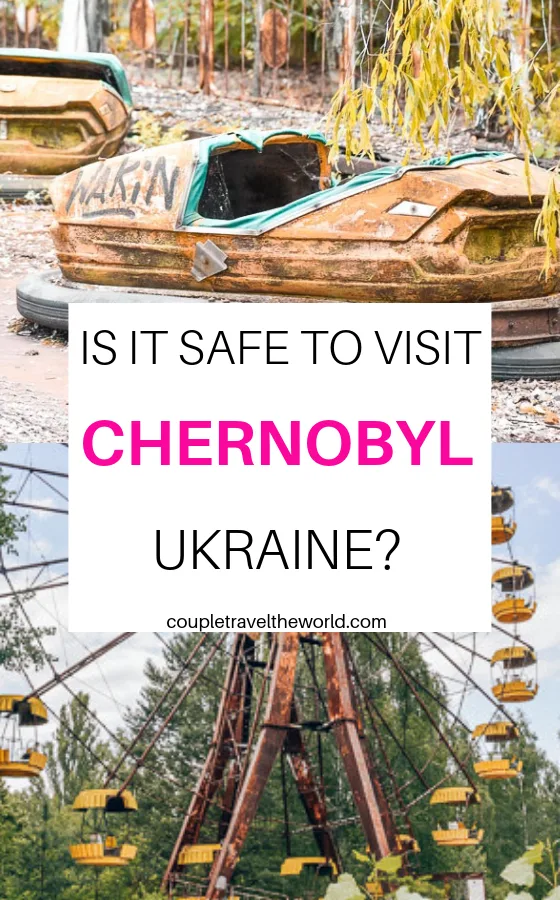In this blog post we’ll share with you tips about visiting Chernobyl on a tour from Kiev, Ukraine. Is it safe? Yes and no – we’ll get to that soon. But first, some context …
At 1:23AM on 26 April 1986 in the town of Chernobyl in the Ukrainian Soviet Socialist Republic (today Ukraine) life for millions of people – and indeed the greater world – changed forever.
An error during a routine safety test created a chain reaction culminating in Reactor 4 at Vladimir Ilyich Lenin Nuclear Power Plant exploding, spewing radiation to the nearby towns and across the continent as far north as Norway and west to Spain.
The explosion released twice the radiation of Hiroshima. Only the radiation continued to be released every hour. It would continue to be released until it could be contained.
It was not meant to be like this. At the time, Chernobyl and the surrounding towns including Pripyat were among the most desirable places to live in the country.
The towns were newly constructed, built to accommodate tens of thousands of workers at nearby Chernobyl nuclear power which had grand designs to become the largest in the world. Five nuclear reactors were in place with a 6th reactor 85% complete and due to be completed in later 1986.
At a time where austerity ruled, Pripyat was held up as a vision of the future.
The residents of Pripyat lived happy, peaceful and prosperous lives with modern hospitals, schools and luxuries like fairgrounds and supermarkets. At the time supermarkets were unknown to most other citizens who still bought meat from the butcher, fruit from trucks, and milk and cheese from the farmer’s wife on the roadside.
Thirty-six hours on from the accident, Chernobyl, Pripyat and the greater area now known as the Chernobyl Exclusion Zone were evacuated – permanently.
Today it is only legal and safe to visit Chernobyl by tour. The town of Pripyat remains as it was, a modern day time capsule of Soviet Ukraine, which has been reclaimed by nature with stunning consequences.
We were fortunate to take a Chernobyl Tour from Kiev. We answer all the questions we had, and others will no doubt have, about visiting the Chernobyl Exclusion Zone… is Chernobyl safe? Am I at risk of radiation if I visit Chernobyl?

Chernobyl Tour Questions and Answers: Do I need a mask?
19 Things to Know Before Visiting Chernobyl
If you chose to visit Chernobyl by tour, stay safe with these tips and plan in advance.
Yes, You can Visit Chernobyl
But only by a tour approved by the Ukrainian government. The Chernobyl Exclusion Zone is guarded by security officers like the border to another country. You will need to show your passport and a permit to enter. The permit is organised by and included in the cost by Chernobyl tour operators.
Chernobyl can be safely visited by tourists
Government officials work closely to monitor the amount of radiation visitors are exposed to. During the majority of our trip, the levels were at or below 0.11 roentgens. By comparison, big cities like London often record everyday readings of 0.08 roentgens. Visitors are provided with geiger counters which measure the radiation levels people are exposed to each day (and presumably monitored by scientists to ensure levels remain safe).
You Don’t Need to Wear a Mask
It is not necessary to wear a mask. However, you can buy a mask and a hazmat suit for effect at the border to the Chernobyl Exclusion Zone. You’ll end up looking like Hank from Breaking Bad!
When Chernobyl happened?
The Chernobyl disaster occurred at 1:23AM on 26 April 1986 in the Ukrainian Soviet Socialist Republic which is known today as Ukraine. At the time it was part of the Soviet Union, which was officially known as the USSR and controlled from the capital, Moscow.
A Chernobyl Size Accident may happen again but not when you visit
After Chernobyl, the RBMK reactors widely used across the USSR were retrofitted with fix the design flaw which contributed to/caused the Chernobyl accident.
That said, there are 450 nuclear power stations currently operating in the world today. Another 60 are planned for construction. While nuclear power is still used, a risk of another Chernobyl type catastrophe remains. In 2011, Japan suffered a nuclear disaster when an earthquake triggered a tsunami which caused a energy accident at Fukushima Daiichi. Although safety precautions have increased since Chernobyl, the Fukushima Daiichi disaster is evidence of the serious risks associated with using highly volatile and incredibly powerful materials like uranium as an energy source.
Chernobyl was considered one of the best places to live before the accident
The nearest town to Chernobyl was Pripyat, a town of approximately 5,000 people.
Most residents lived in large block apartment buildings, as were common in the Soviet Union at the time (Union of Soviet Socialist Republics – shortened to USSR).
By all accounts, life was extremely good in Pripyat before the accident. People lived more modern lives than elsewhere in Ukraine.
It’s fascinating yet sad to see how life was back then as much of the buildings remain untouched.

We learned Pripyat was a thriving town featuring one of the first supermarkets in Ukraine – a rare feature in the communist country
Here’s Why the Chernobyl Accident happened
Uncovering exactly what happened in Chernobyl is a task which is continuing until today. The Soviet regime at the time covered up the occurrence to preserve its reputation and avoid negative economic consequences.
Simply put, the Chernobyl disaster was caused by an unfortunate combination of human, mechanical and design errors during a safety test. The errors culminated in a sudden release of enormous amounts of energy which vapourised water intended to cool the nuclear reactors, causing a steam explosion which ruptured the core exposing uranium fuel rods and releasing radiation said to be 400 times that which was released when the Hiroshima bomb was dropped.
Here’s how Wikipedia describes the Chernobyl disaster in more detail:
The accident started during a safety test on a common Soviet reactor, the RBMK type. The test was a simulation of an electrical power outage to aid the development of a safety procedure for keeping reactor cooling water circulating until the emergency generators could provide power. This gap was about one minute and had been identified as a potential safety problem which could cause reactor core overheating. Three such tests had been conducted since 1982 but had failed to provide a solution.
On this fourth attempt the test was delayed by ten hours, so the operating shift that had been prepared was not present. The test supervisor then failed to follow the procedure, creating unstable operating conditions which, combined with inherent RBMK reactor design flaws and the intentional disabling of several emergency safety systems, resulted in an uncontrolled nuclear chain reaction.
A very large amount of energy was suddenly released vapourising superheated cooling water and rupturing the reactor pressure vessel in a highly destructive steam explosion. This was immediately followed by an open-air reactor core fire. The core fire released considerable airborne radioactive contamination for about nine days which precipitated onto parts of the USSR and western Europe, before being finally contained on 4 May 1986.
The radioactive contamination dispersed over this period was approximately the same amount as that released during the initial explosion.
Chernobyl was a horrible event, the effects of which were felt – and continue to be experienced – by people, animals and nature today.
It was this aspect we were interested to learn more about on our visit to Chernobyl, Ukraine.

This is What you see on a Chernobyl Tour
On our Chernobyl tour we had the opportunity to see (from a safe distance) and later visit some of the most iconic, interesting places in Chernobyl including:
- Reactor No. 4 (encased by the Chernobyl sarcophagus, now encased again by a monumental dome);
- Pripyat town;
- an abandoned fairground;
- deserted swimming pool “Azure”;
- an eerie, sad abandoned kindergarten; and
- the Russian Woodpecker (not what we imagined).
We chose to take a day tour of Chernobyl from Kiev. As Chernobyl is 100km (60 miles) north of the capital, Kiev, we set off at 8:15am.
On the 2 hour drive from Kiev to Chernobyl (actually, the check-point to the Chernobyl Exclusion Zone) we watched an informative documentary about the Chernobyl accident. Less dramatic than HBO’s Chernobyl, but very interesting.
A second documentary showed the incredible engineering feat recently achieved to create a new ‘dome’ structure which covers Reactor 4 and a decaying building known as the Chernobyl sarcophagus which was built after the disaster to contain the radiation (more on that below).
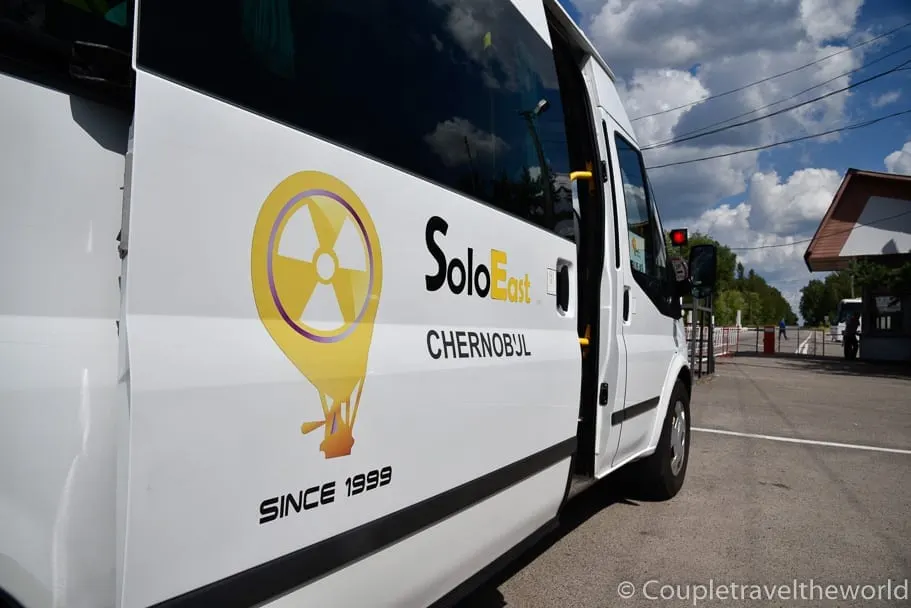
SoloEast Chernobyl Tour bus at the Chernobyl Exclusion Zone border
Watch HBO’s Chernobyl miniseries before you go
If you haven’t already watched the Chernobyl series, I recommend watching it before you go.
We actually hadn’t seen the series before visiting but it was still interesting spotting places we’d visited watching the show later on.
On the tour our guide pointed out places like hotel Dr Valery Legasov stays during his time managing the Chernobyl crisis.
But if you watch it first you’ll probably pick up even more interesting details. Speaking of HBO’s show …
What’s Pripyat Town like today?
For viewers of HBO’s hit series Chernobyl, you may recognise Pripyat town square, including the hotel Dr Valery Legasov stays during his time managing the Chernobyl crisis.
The difference today is striking as nature has reclaimed the square with trees metres tall creating a mini-forest.

Chernobyl hotel seen in HBO Chernobyl (photo taken in 1986 in the foreground)
Visit one of the world’s most iconic “Abandoned Places” Azure Swimming Pool
This indoor swimming pool in Pripyat town is within the zone affected by the Chernobyl accident.
Today, the pool stands empty and frozen in time. The forest of trees which have overgrown Pripyat town reach their limbs into the desolate building.
The building also houses an indoor basketball court (watch out for the decaying floors).
The Chernobyl swimming pool is one of the most eerie sights on our Chernobyl tour.
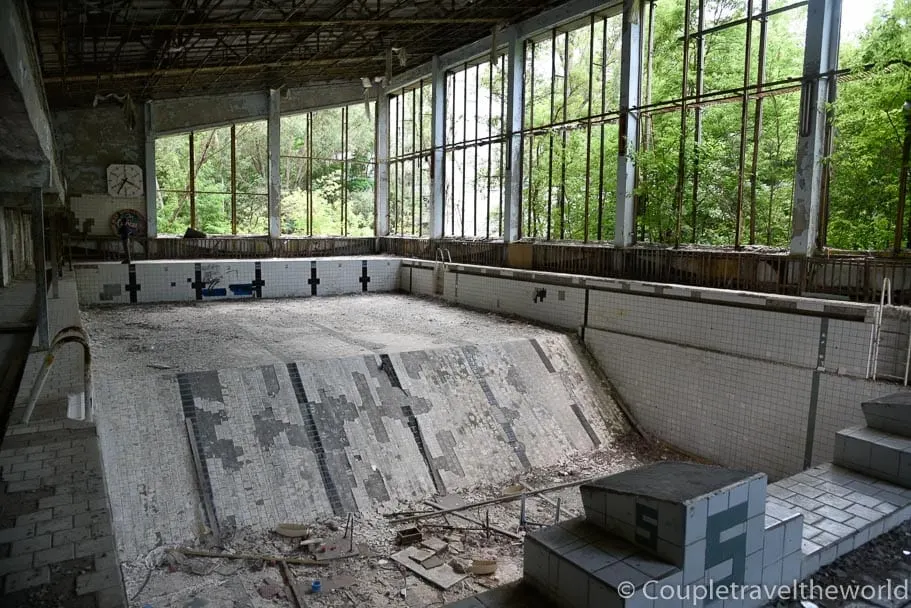
Eerie abandoned swimming pool in Chernobyl Exclusion Zone
You can see the Chernobyl sarcophagus
It took over a month for authorities to determine how best to contain the radiation spewing from the broken Reactor 4.
Eventually, it was decided that Reactor 4 would be encased in a huge building with 7 metre thick concrete walls.
This construction was known as the Chernobyl ‘sarcophagus’.
The Chernobyl sarcophagus cannot be seen today as the building began deteriorating from the radiation and from lack of maintenance due to the difficulties with working near the highly radioactive site.
At Chernobyl today you can see a magnificent feat of engineering – the Chernobyl ‘dome’ which was constructed at a safer distance 300 metres away and autonomously rolled over the Chernobyl sarcophagus to contain the radiation.
The dome is designed to last 100 years, features an advanced ventilation system and a a robotic arm-like cranes which are designed to slowly deconstruct the deteriorating ‘Chernobyl sarcophagus’ building.
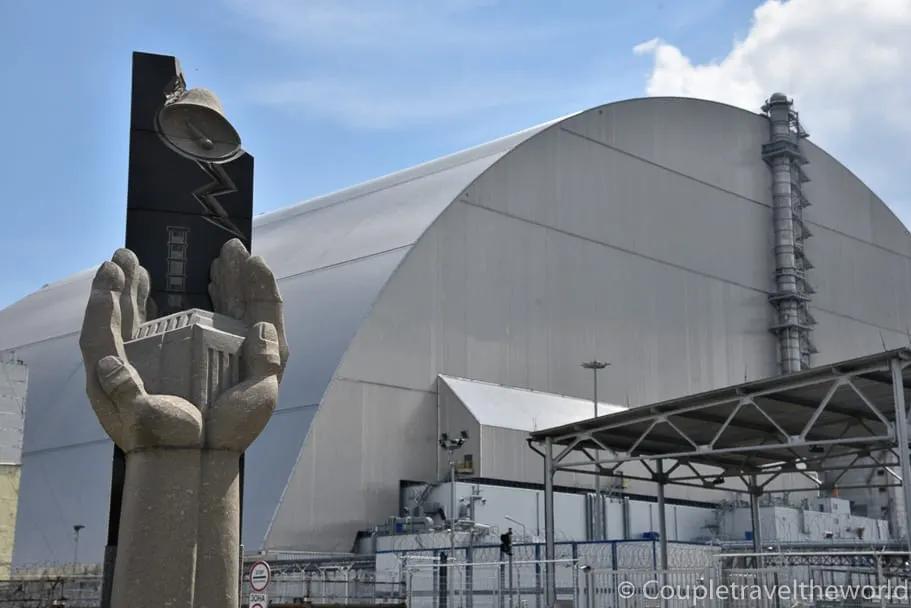
Chernobyl Dome – costing over $1 billion – covering the deteriorating Chernobyl sarcophagus which houses Reactor 4
Don’t Eat ANY food around Chernobyl
Chernobyl is probably the only place on earth where you can promote the produce as 100% not locally sourced, and everyone will be happy.
On our tour we were provided with a large chicken breast or piece of pork, with rice and a cabbage, cucumber and tomato vinaigrette salad.
Inside the exclusion zone you are prohibited from eating or drinking as you face a risk that if radiation-filled dust particles fall on your food, which you then eat, the radiation particle could stay inside your body and cause cancer.

Lunch in Pripyat served on our Chernobyl tour
Animals in Chernobyl are thriving without humans
One of the most bittersweet aspects of Chernobyl is that where people have long gone, animals have returned in abundance.
The Chernobyl exclusion zone is now rich with fauna including European bison, wolves, foxes, herds of wild horses, giant catfish and many more animals which had previously left.
The return of life to even such an inhospitable place may provide hope that if in the future we can stop destroying our environment, the damage we have caused isn’t irreparable.
During the few hours we spent wandering the nature-reclaimed streets of Pripyat we didn’t come across any large animals. If you want to see Chernobyl animals we recommend you take a 2 day Chernobyl tour to maximise your chances.
Our guide confirmed she has seen many of the above animals personally. You can check out the tour’s instagram page for more Chernobyl animals.
People Still Live in Chernobyl
Before visiting Chernobyl the thought didn’t even cross my mind about whether people still live in Chernobyl.
If you’d asked me – I would have said no way. But I would have been way wrong.
If you chose to take an overnight Chernobyl tour, it is sometimes possible to meet with some of the Chernobyl resettlers and visit their homes.
Although it might sound crazy, many of the residents of Chernobyl wished to return to live there, despite the risks of radiation.
It would have been completely irresponsible to allow children to be exposed long-term to such radiation.
A compromise was struck where people over the age of 50 were permitted to return and live permanently in the town of Chernobyl and other towns within the exclusion zone.
To this day you can find several streets in Chernobyl which have almost all the facilities you need to live a regular life – supermarkets, post office and other shops.
Several shuttles run daily from Chernobyl town to Kiev. These are for Chernobyl residents only, and they may only travel with appropriate permission and paperwork from the government.
Although we didn’t take an overnight tour, we saw many Chernobyl resettlers taking the bus to Kiev as we were also passing through security as we left the Chernobyl Exclusion Zone.
We didn’t take any photos of the Chernobyl resettlers to respect their privacy.
Bring your camera for the eerie Chernobyl Kindergarten
One of the most eerie parts of our tour was visiting an abandoned kindergarten.
The yard and building are splattered with creepy looking dolls with limbs removed.
It was also incredibly sad seeing tiny pairs of shoes left as if they had no time to even contemplate putting them on.

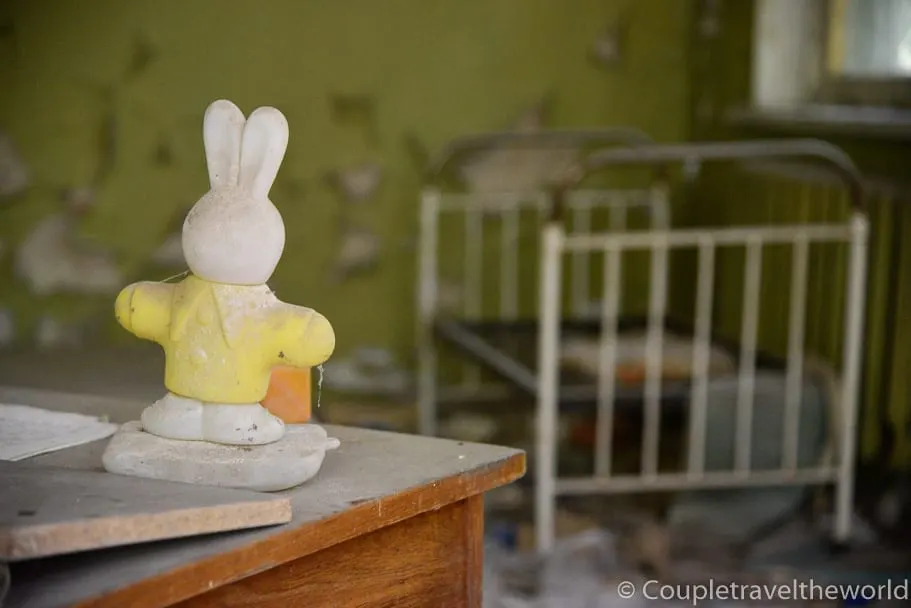
Lost toys … empty beds …
You’ll spot a Russian Woodpecker
One of the most striking relics of the Soviet era we saw on our Chernobyl tour was the Russian Woodpecker.
When we were told we’d visit the Russian Woodpecker later in the day, our thoughts raced to the animal variety. We were wrong.
The Russian Woodpecker is a Goliath structure of metal and wire. It is actually a ‘Duga radar’ which was part of the USSR early-warning radar network.
The 85 metre tall structure was used to detect missiles over the horizon during cold war times. It is the only Duga radar still in existence. Unlike it’s counterparts the Chernobyl Russian Woodpecker can’t be dismantled due to its location within the Chernobyl Exclusion Zone.
Why is it called the Russian Woodpecker you ask? Although it’s existence was highly secret (it was even marked as a kindergarten on official soviet maps) locals could pick up the signal on any AM radio. The transmission sounded like a woodpecker knocking its head against a tree.
Today, the structure stands as an eerie remnant of the cold war era. As someone not old enough to remember the cold war era, this monumental structure which stretches 200 metres wide was a striking illustration of another disaster the world fortunately avoided.
Do NOT Walk in the Red Forest
A smaller fact we would have missed when watching HBO’s Chernobyl, if we hadn’t taken this tour, was the impact of the Red Forest.
One of the tragedies of the Chernobyl accident is that the power plant was constructed in one of the largest forests in the USSR.
Not only is this land, and the animals within it, almost permanently ruined. At the time of the disaster, aside from the rooftop of Reactor 4 and the surrounding building, the Red Forest had the highest levels of radiation in the area.
In HBO’s Chernobyl you might recall a short opening scene where unaware cyclists were passed on the road by fleets of buses and military vehicles.
Later in the series there’s a shot of the abandoned bicycle in one of the fields near the forest.
Knowing now that the Red Forest these cyclists presumably passed through was one of the worst places to be at the time, you can imagine their sad fate.
Many people who fled Chernobyl and Pripyat by car drove through the Red Forest, rather than the main roads, and were exposed to some of the highest levels of radiation. I believe the fate of the cyclists in part symbolises the plight of these people.
We drove through the Red Forest on our Chernobyl tour and you can see the Geiger counter spiked even inside the bus.
What to Expect: Pictures of what Chernobyl looks like today
Today Chernobyl has been overgrown by plants. The city reclaimed by mother nature.
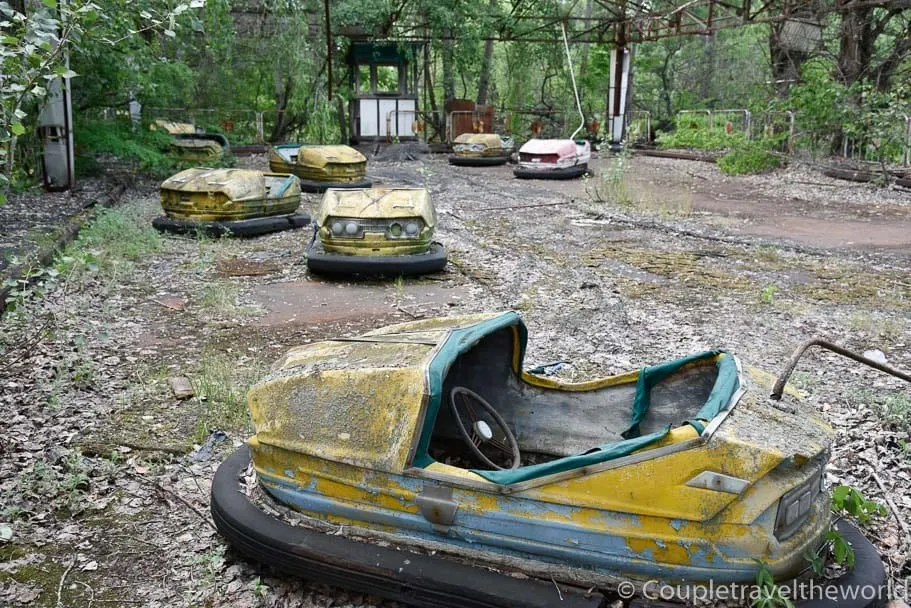
Dodgem cars which never had the chance to be used
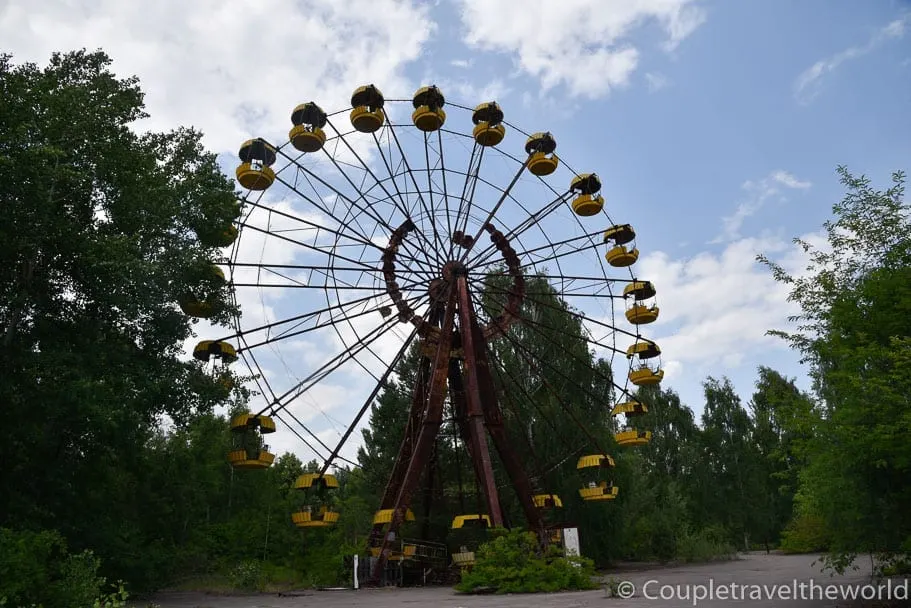
This Ferris Wheel in Pripyat was due to open days before the Chernobyl disaster
Chernobyl Tour Provider & Information
We visited Chernobyl with SoloEast Travel. We were really pleased with out tour and the service provided.
Before the tour we were given information about what to wear, how to safely behave in the exclusion zone, what to bring (passports), where to meet, availability of ATMs near the exclusion zone (there’s 1 and it doesn’t always work) and dietary options for the lunch provided.
Tip: Book your tour at least 2 business days in advance to avoid paying an extra $50 fast-track processing fee charged by the government.
On SoloEast’s Instagram account you will find even more photos of Chernobyl animals, the military cemetery and other interesting abandoned places in Chernobyl.
Website: www.tourkiev.com/
Instagram: ChernobylTours
More Ukraine Blog Posts
There is so much more to see in the Ukraine – Chernobyl is just the tip of the iceberg.
Kiev travel blog posts
Is it safe to visit Kiev, Ukraine? – one of the first questions for any prospective Ukraine visitor. With the said Chernobyl disaster and more recent tensions with Russia, you’re right to ask the question. We’ve got the answers with some useful tips to keep you safe.
Independence Square Kiev – you must visit the heart of Kiev to experience this beautiful, people-filled square. Here’s 5 interesting things to spot while you visit Maidan Nezalezhnosti
Golden Gate Kiev – What is it? What’s the history behind it? Why is this a must see in Kiev? Find out
St Michael’s Cathedral Kiev – the stunning golden-domed cathedral is a must on any Kiev itinerary. But what’s the history behind it? How old is it? If you guessed hundreds of years old you would be wrong!
Best Cafes in Kiev – iced coffee served in a whiskey jar, delicious cafes and lattes plus a 24 hour cafe. These are the best Kiev cafes you have to try
Lviv & wider Ukraine blog posts
Lviv is a stunningly quaint, walkable city in Western Ukraine with Austrian-style buildings, delicious food (and chocolate), and a happy, fun atmosphere.
Lviv is one of the most popular tourist cities in Ukraine but the secret isn’t out yet, so most tourists are still Ukrainians – always a great sign!
Tunnel of Love Ukraine – this green tunnel of trees along an old railway line is stunningly beautiful but also houses a bloodthirsty secret
Lviv High Castle – what’s to see at the highest point in Lviv which is also one of the best rated attractions in Lviv? Read this before visiting (and thank us later)
The Best Restaurants in Lviv – underground mines serving coffee which is flambéed with a flamethrower at your table, masonic restaurants with fake, secret entrances and underground bunkers with a secret password where you can shoot Putin’s head. These are just 3 of our favourite restaurants in Lviv. For the bunker password and more interesting and quirky Lviv restaurants – don’t miss this post.
Lviv Opera – in Lviv old town is a beautiful opera. But the best way to see the stunning architecture is buy an opera ticket (starting from $2 USD) to enjoy the performance and the beautiful interior.
Nightlife in Lviv – want to know more about the best bars, clubs and after-dark places in Lviv? It’s not just the restaurants in Lviv which are quirky. There’s funky M15+ BDSM bars which will have your group in hysterics too.
Lviv Cafes – not to be outdone, the cafes in Lviv are far more interesting than any Starbucks. Of course you’ll get great coffee in Lviv but you can partner it with delicious side-dishes like a cup of melted milk chocolate. It’s divine.
Lviv to Krakow – or Krakow to Lviv. These towns border each other. Lviv is far closer to Krakow than Kiev. In fact, before the world wars Lviv was a part of the Austrian empire (which is why Lviv and Krakow both having stunning Austrian-styled houses). Getting across the border by bus is simple – we’ll walk you through it.
Save this Chernobyl Blog to Pinterest (so you can find it again later!)


